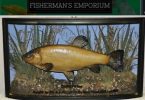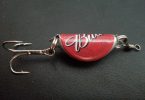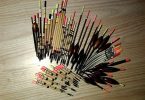To early man, catching fish was an important food-gathering activity. As far as we can tell, however, fishing was never a chore. Then, as now, it always involved excitement, use of imagination and intellect. Just when the primary reason for fishing became sport, rather than a means of survival, is impossible to determine – the two elements were and, in many parts of the world, still are intrinsically linked. But it does seem that when food requirement became of secondary importance, artificial restrictions on the chances of success were introduced to ‘give the fish a chance’. That is why anglers use rods, lines and baited hooks, while commercial fishermen employ much more productive methods.
The fish hook was one of man’s earliest tools. Originally, it was used as a gorge, an inch or so in length and made from wood, bone or stone, sharpened at both ends. The baited gorge was jammed into the fish’s mouth when the line attached to the middle of the shank was pulled. The advent of metal-working stimulated the manufacture of the first metal fish hooks, which were tied to a line made from animal or vegetable fibre. Such a combination would have been effective when used from a boat, but our forebears must then have come to realise that if the line were fastened to a stick or branch, the angler could fish over the marginal vegetation from the bank.
There is no archaeological record of when rods were used first, although we do know that they were being employed by 2000 B.C. It was not until Roman times, however, that there were references to longer rods made into sections. The Roman writer Aelian even gave details of dressings for artificial flies used by the Macedonians when dapping for trout.
Civilised man has long represented the sport of angling in art and literature. Figures fishing are depicted in Ancient Egyptian painting, and there are references to angling in the works of Homer and the Old Testament prophets. In the fourth century B.C., Chinese writings referred to fishing with a bamboo rod, a silk line, and a hook made from a needle and baited with cooked rice.
A major development in the historical literature of the sport came with the advent of printing in Europe. At Westminster in 1496, the Treatyse of Fysshynge with an Angle was printed, part of the second edition of The Boke of St. Albans. This was the first fishing manual and is believed to have been written by Dame Juliana Berners, Prioress of St. Albans.
Since then, the outpourings of angling literature have continued nonstop, to such an extent that more has been written about angling than about any other sport. By far the most famous of these works is Izaak Walton’s The Compleat Angler, though much of its contents are now thought to have been ‘borrowed’ from earlier works.
Fishing Tackle
The type of fishing tackle used at the end of the Middle Ages changed little for many hundreds of years. The rod was a pole of up to 20 ft. long, the line made from horsehair tied to the end.
By the 17th century, it was discovered that, by fixing a ring to the end of the rod, it was possible to use a longer, running line which gave better control over a large fish. In 1667, Thomas Barker mentions a salmon line of 26 yards in length, necessitating some form of winder or reel (though the Chinese had designed one by the end of the 13th century). Technical advances were accepted slowly, as evidenced in 1726 by references to the existence of rods with rings along their length and the use of a ‘winch or wheel’, although it was added that such devices were not in common use.
Much of the early fish hook industry was centred near Old London Bridge, but it was dispersed by the Great Plague in 1665, and then by the Fire of London a year later, to Bristol, Dublin, Limerick, the English Lake District and, finally, to Redditch, in Worcestershire, where needlemaking can be traced back to monastic times. By 1780, hooks were being exported from Redditch to the USA and Jamaica, and by the beginning of the 19th century the town had become the centre of the world’s fish hook manufacture.
The efficient industrial production of fishing tackle, and its relative decline in cost, had an important influence on the development of angling. By 1770, rods with rings along their whole length and with fittings to take a reel had become common. At that time, the centrepin had become the classic British fishing reel, developed in the lace-making town of Nottingham. This reel, based on the wooden lace-bobbin, was free-running, with a large diameter drum, which held a considerable length of fishing line and allowed large sections of the river to be fished with comparative ease. Soon it became adapted for sea fishing and as the model for fly fishing reels.
The use of tough, elastic woods imported from South America, the West Indies and the Far East (lancewood, green heart, bamboo, etc.) greatly improved the performance of rods. Even before the 19th century, attempts had been made to glue together strips of bamboo, and by 1847 the top sections of rods were being made from this material, known as ‘split’ or ‘built’ cane. By 1870, complete rods of built cane were available in Britain and the USA.
The invention of the ‘Malloch’ reel in 1880 (on which casting was facilitated by turning the drum through 90 degrees) made longer casts possible. Then, in 1905, a Bradford textile worker, Holden Illingworth, invented the fixed-spool reel, and this type of reel has dominated much of world angling ever since.
There have been vast improvements in tackle technology in the 20th century. Reels are now much lighter in weight, more efficient and hardwearing. Fibreglass replaced built-cane as a rod-making material – then, in turn, it has been largely superseded today by carbon fibre.
Fine, strong and cheap nylon monofilament is now the line in universal use, with man-made braids and high-strength, low diameter lines offering opportunities for longer casting and more efficient bite detection. Fly fishermen have access to a large range of plastic-coated lines which sink, or float, in a reliable manner, according to their specifications, and recent innovations includes fly lines which are claimed to be invisible to fish!
Organising Angling
It is probably because of the very nature of the sport that anglers have, until quite recent times, been lone individuals or small friendship groups, pursuing a quiet and ancient craft. Despite the flourishing tide of angling literature and tackle developments, the first organisation dedicated to angling matters did not appear in Britain until the late 18th century: in 1792 a club was formed to fish Dagenham Lake in Essex, one of the most distinguished anglers fishing there being William Pitt – at 23, Britain’s youngest-ever Prime Minister.
The clubs which emerged after this were largely social in nature. At that period, there was a great deal of fishing available for a relatively small number of anglers, and the banding together of groups of clubs to ensure access to water by taking up tenancies did not begin until later. As the 19th century and, more importantly, the Industrial Revolution progressed, the advantages of angling associations became more apparent.
Many impoverished industrial workers from the rapidly developing slum cities turned to poaching as a means of supplementing their meagre food supply. Fish had long been a source of food, but now the theft of fish was carried out on a large scale. Simultaneously, large fish mortalities were occurring, and by the turn of the century the uncontrolled pollution from a vast array of industries had destroyed many of our premier rivers. For example, the salmon which used to run up the River Don, in Sheffield, were wiped out and the river became a lifeless, chemical drain.
One of the benefits of the Industrial Revolution, though, was that it provided anglers with a convenient means of travel – the railways. By the latter half of the 19th century, urban workers were taking advantage of the cheap, reliable travel offered by the railway network. Indeed, during the 1870s, angling clubs in the London area had already been negotiating successfully for cheap travel concessions for parties of anglers. This escape from the place of work and residence made it feasible for anglers not only to get into the countryside but also to rent and re-stock distant waters.
As angling associations grew in site and number, their attention turned as well to improving the quality of the waters in which they fished and the condition of the fish in those waters. To this end, anglers encouraged and supported legislation to control water pollution and over-exploitation of fish stocks (e.g. by the introduction of the close season, in 1923), and in 1948 the Anglers’ Co-operative Association was formed to invoke the provisions of the Common Law against polluters, which it has achieved with unrivalled success ever since.
Today, there are hundreds of millions of anglers worldwide, supported by a large and complex tackle industry. In many places, pollution, overcrowding and competition for resources have complicated the ‘simple’ sport of angling. Yet the plain fact remains that, everywhere, people still derive deep and lasting pleasure from this most ancient of pursuits.
**********
Prepared by: Dr Bruno Broughton
bruno.broughton@virginnet.co.uk







